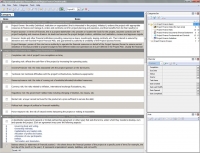|
Task Management Software |
 |
|
|
|
|
| |
|
 TESTIMONIALS TESTIMONIALS
|
|
"...This is an excellent program. I'm so glad that I stumbled on to this when researching for task management programs. Very low learning curv, quite flexible, and the price is right. Tried at least 20 other programs, either too complicated, too expensive, or poor documentation..."
Chad Lindsey -
Honolulu, HI
|
|
|
|
|
|
|
|
Project Finance Checklist |
|
|
|
|
|
|

 |
This Project Finance checklist embraces different aspects of project financial management that is concerned with the acquisition, financing and management of project’s assets and activities while pursuing the project’s overall objectives, such as getting results and pay-back revenues. With a help of studying this checklist you can obtain an outlook on some fundamentals of this important branch of project management, securing investments and interests of the project’s stakeholders (such as composing the Project Financial Plan, learning project finance roles, documents, etc).
|
| Order 750 checklists in MS Word and PDF printable format at $49.99 USD only. |
BUY NOW!  |
Project Finance Basics:
- Roles (the main ones):
- Project Owner: the entity (individual, institution or organization) that is interested in the project, initiates it, endows the project with appropriate resources to finance and manage it, orders and contracts work for project planning and execution, and then benefits from its final result(s) or product(s). Project Owner and Project Sponsor often are the same entity or person;
- Project Sponsor: in terms of finances, this is a project stakeholder who provides or locates the funds for the project, assumes controls over the project budgeting and revenue streams. He leads and secures the project budget creation, validation and realization, reviews and approves regular project’s financial reports, and also assists and supports the Project Manager in dealing with external/internal financial resources and operators. He owns the opportunuties and risks related to the financial outcome of the project;
- Financier: banks and other financial institutions providing resources as loans, investments, leasing contracts, etc. Their interest is assured by attractive and well-founded Project Financial Plan, and guaranteed by authority & credibility of the Project Sponsor/Owner;
- Project Manager: person of this role has an authority to operate the financial resources on behalf of the Project Sponsor/Owner to ensure normal utilization of moneys provided to project’s budget to feed different tasks and operations as it is pre-defined in the Project Plan. Usually the financial activity of PM is supported by specialized assistants who provide him with professional and qualified help on accountancy, assets management, financial planning, control, and decision-making;
- Risks:
- Completion risk: risk of project’s non-completion on-time;
- Operating risk: affects the cash-flow of the project by increasing the operating costs;
- Owners/Financier risk: the risks associated with the project sponsors or the borrowers;
- Technical risk: technical difficulties with the project’s infrastructure, facilities & equipments;
- Resource/reserve risk: the risks of running out of available/allocated/calculated resources;
- Currency risk: the risks related to inflation, international exchange fluctuations, etc;
- Regulatory risk: the government-related risks including changing of taxation, law issues, etc;
- Market risk: a buyer cannot be found for the product at a price sufficient to service the debt;
- Political risk: danger of political or financial instability;
- Force-majeure risk: the risk of natural events hampering the project or making it impossible;
- Documents (Financial Statements/Reports):
- A stockholder agreement (general or limited partnership agreement or other type) that sets the terms, under which they investors develop, own and operate the project. Such an agreement may cover the following aspects:
- Governing body and voting.
- Ownership interests.
- Capitalization and capital calls.
- Allocation of profits and losses.
- Admission of new participants.
- Default.
- Termination and dissolution.
- Balance sheet (or statement of financial position) – this sheet shows the financial position of the project at a specific point of time (for example, the last day of the month or the year). It represents organization’s assets, liabilities, and net worth;
- Income statement (also called profit & loss account) – this document shows revenues, minus the cost of goods sold, minus operating expenses, plus other revenues and expenses and the net income/loss before taxes;
- Cash flow statement – shows the detail of cash received and cash expended for each month of the year (the inflows and outflows of cash). A projected cash flow statement helps you to determine if the project has positive cash flow;
- Statement of changes in owners’ equity or stockholders’ equity;
- Fundamentals and Controls:
- Setting up an accuracy level required in making calculations on costs;
- Clarifying organization’s funding constraints and policies;
- Setting up project priorities (costs, quality, scope, time) to focus the financial planning on;
- Setting a system and roles for keeping accounts and records;
- Putting in place procedures for managing the reports (Financial Statements);
- Setting accounting and finance staff;
- Setting up appropriate mechanisms and techniques for budget monitoring;
- Setting up reasonableness, allowability, and allocability of costs;
- Setting up the Internal/External Controls and Financial Reporting;
- Organization of the processes for management and systematization of the Accounting Records and Source Documentation;
- Establishing the Cash Management;
- Establishing the Compliance management to keep finances complying with the state laws, regulations, local ordinances and other legal requirements;
- Establishing the Assets Management (see Asset Management checklist);
- Guidelines:
- Clearly name and categorize the financial expenses (buying, leasing, renting, contracting);
- Use clear & transparent mechanisms and models for measuring and calculating the financial expenses, recognize and mitigate their risks (these models should be represented in the Project Financial Plan to convince the Project Owner/Sponsor/Financier);
- Make sure that your project’s Financial Plan has been independently scrutinised before approaching the Sponsor/Financier;
- Ensure that everything possible was done to:
- Minimize the elapsed time between the work completion and receiving the payment for it;
- Obtain progress payments rather than payments based on acceptance of deliverables;
- Avoid holdbacks on milestone payments;
- Avoid paying subcontractors prior to getting paid by the customer;
- Modern approaches requires using software: while the financial reports & statistical documents can be managed with a help of Excel-based solutions (or any other effective spreadsheets), working tasks and time of financial specialists can be planned and controlled via using VIP Task Manager
Project Finance Process:
- Determination of Funding sources (such as a loan to be paid back over a long time, government or private sponsorship for non-profit projects);
- Drafting the Project’s (Work) Plan, and making sure of adequate evaluation of financial risks;
- Realistic estimating of the total costs of all elements involved into completing the project, which could be constituted of:
- The total costs of each project’s task or activity, calculated from costs for raw materials, labor of manpower, working hours of equipment, etc. necessary to complete these efforts;
- The total costs of raw materials required to complete the entire project;
- The total costs of energy and other resources required on project;
- The total costs of acquiring, renting, ongoing operating, maintenance, and repairing/servicing of the project’s premises, equipments, vehicles, tools etc;
- The total administrative costs necessary for paying taxes, operating the project tasks, etc;
- Creating a schedule of expenses (including different taxes, employee remunerations, etc) to see how the costs are allocated over the project timeline;
- Accomplishing solid financial analysis with testing different scenarios and approving the key ratios. Completing due diligence with well respected consultants;
- Completing the Financial Plan to justify demand for funds, ...
| Order 750 checklists in MS Word and PDF printable format at $49.99 USD only. |
BUY NOW!  |
|





 |
CentriQS Tasks Management Solution 
Looking for multi-user task management software? Try CentriQS complete task management solution for planning, tracking and reporting tasks, projects, and schedules. Increase productivity of your small business or office by better organizing your employees' tasks and time.
 FREE Download CentriQS FREE Download CentriQS
|
|
|
|
|
|
|
|
|
|
CentriQS  -15% OFF -15% OFF |
All-in-one business management software
for small and midsize enterprises |
 |
|
|
| VIP Task Manager |
Multi-user project management software
to plan, schedule and track project tasks. |
 |
|
|
| VIP Checklists
|
More than 750 ready-to-use to-do lists
to plan your personal and business life |
 |
|
|
| VIP Team To Do List |
Professional task management software
to make and send team todo lists by email |
 |
|
|
| VIP Organizer |
Personal time management software
to organize time at home and at work |
 |
|
|
| VIP Simple To Do List
|
Simple and effective to-do list software
to plan daily chores, trips, wedding, etc. |
 |
|
|
|
|
|
|
|